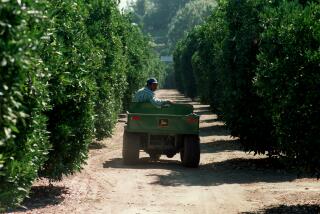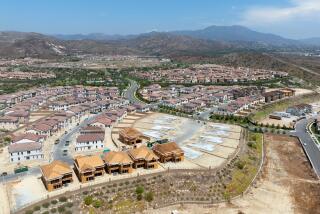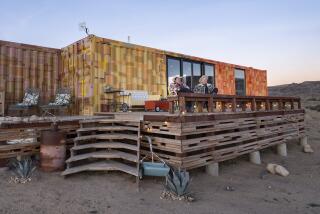Photo Book ‘Chronicles, Celebrates’ Irvine Ranch Over Past Four Decades
In the grand tradition of corporations that self-publish books, the Irvine Co. is putting out a lavish 5-pound valentine to itself. But the pictorial chronicle, put together by renowned designers, is marked by one crucial difference: It is not about the company itself, but about the land that gave birth to a ranch and eventually a city.
“Irvine Ranch: Different by Design, images 1960-2000” ($49.95) showcases the 93,000-acre ranch’s natural beauties and master-planned architecture in more than 300 striking photographs.
The company printed 2,500 copies, some of which recently arrived at gift shops in four resort hotels on Irvine Ranch land. Other copies have been sent to business and community leaders, and more will go to bookstores on ranch property.
But even though the oversized book was a pet project of Irvine Co. Chairman Donald Bren, plans for similar books had started and stopped several times at the company.
Bren, who wrote the preface, rarely grants interviews and was unavailable for comment. But company Vice Chairman Ray Watson said, “Donald wanted a kind of book that both chronicled and celebrated what has happened on the Irvine Ranch in the last 40 years. . . . [He] was involved in every page and particularly the photo selections.”
“The photographic images are just stunning,” said Irvine Mayor Larry Agran, “and I think they capture the remarkable transformation of the Irvine Ranch, while at the same time they capture the old California that so many of us knew--and know--and want to retain in perpetuity.”
Bren first approached Paul Kranhold, then vice president for corporate marketing, about doing a book on the Irvine Ranch 15 months ago.
Kranhold said Bren, a collector of modern art who also has an extensive collection of art books, had a clear idea of what he wanted the Irvine Ranch book to be.
Kranhold hired Garrett White, then head of publications for the Los Angeles County Museum of Art, to produce and edit the book. “He’s produced dozens and dozens of books and very much took it in the direction of an art book,” said Kranhold. “He took it up to a whole other level, a place where Donald wanted it.”
White put Kranhold in touch with the book’s designer, Simon Johnston of Santa Monica, who has designed many art and architecture books. White also recommended Gardner Lithograph of Buena Park, one of the country’s premier printers of art and photography books and the only printer authorized by the estate of legendary photographer Ansel Adams.
Coincidentally, the book includes a handful of black and white photographs shot by Adams, who was commissioned by the University of California regents in the mid-’60s to photograph the new UC Irvine campus.
The Irvine Co. obtained the Adams pictures from the University of California, and with few exceptions, Kranhold said, only existing photographs from the Irvine Co. and various archives were used in the book. He would not say how much it cost to publish the book.
It also was Kranhold who dug up information about the earlier attempts to publish. One was for a book on the master plan that would have been geared to urban planners.
Before beginning work on it, Kranhold reviewed other books that have been self-published by major companies with long histories, such as John Deere and Bechtel.
“What differentiated this book from those books,” he said, “is they were really about the companies, the organizations. This book is not about the company; it’s about the place.”
Kranhold left the company in February but continued working as a consultant until the book was completed.
Acquired by James Irvine in 1876, the Irvine Ranch changed from a livestock operation to agriculture in the early 1900s, orange groves and row crops supplanting the cattle and sheep.
But with the exception of a section on the 125-year old ranch’s history in the beginning of the book, Kranhold said, the decision was made to focus on the last four decades, the period of master-planning and development.
“A decision was made to master-plan the property before any large-scale development took place, so we wouldn’t have another Los Angeles on our hands. The idea was to do something better, something different.”
Which, Kranhold said, inspired the book’s subtitle, “Different by Design.”
More to Read
Sign up for our Book Club newsletter
Get the latest news, events and more from the Los Angeles Times Book Club, and help us get L.A. reading and talking.
You may occasionally receive promotional content from the Los Angeles Times.






